The most popular custody schedules are ‘Every Other Weekend’, ‘3-2-2’, ‘Every Other Weekend Plus a Mid-Week Visit’ and ‘Week About’. Let’s look at examples of all the top child visitation schedules by age.

How to Make Your Own Schedule Online
The visitation schedules shown are examples only. You can join Timtab to make a free schedule using time-pattern AI technology. The schedule may have stages and will account for:
- child ages
- multiple children
- travel times
- work hours
- school breaks
- user preferences.

50/50 Custody Schedule Examples
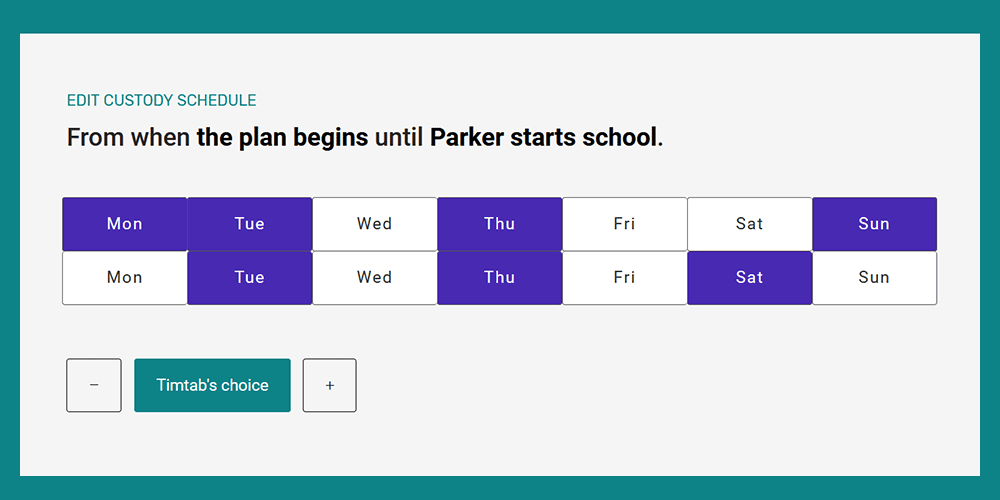
2-1-1-1-1-1 (6 visits a fortnight)
For a preschool child, the best 50/50 schedules have frequent changeovers. Getting to 50/50 can be done by having 6 visits a fortnight with each parent, including a stay of two nights.
Ages 0-5
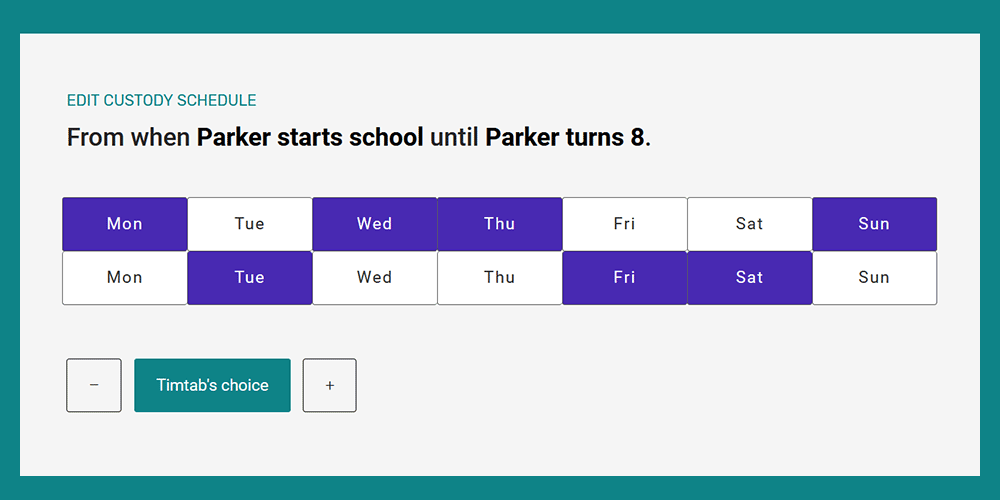
1-2-1-1-2 (split weekends)
Around the ages 5 to 8, kids are very active and want to see both parents often. The “split weekends” schedule is well balanced and can be used if parents live near one another.
Ages 5-8
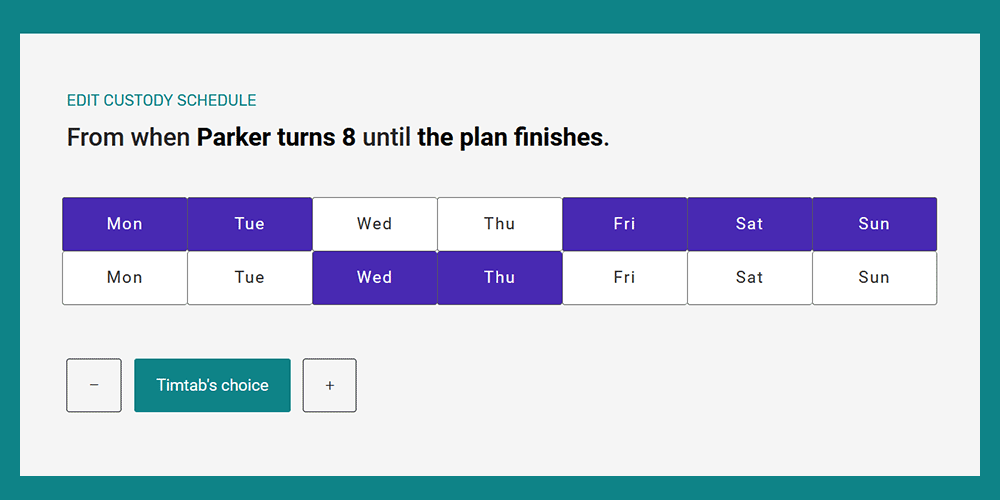
3-2-2 (alternating blocks)
A popular schedule when parents are both close to school is 3-2-2. Each parent has 3 nights on alternate weekends and a pair of weekday nights every week. The schedule is ideal for ages 8+.
Ages 13+Ages 8+
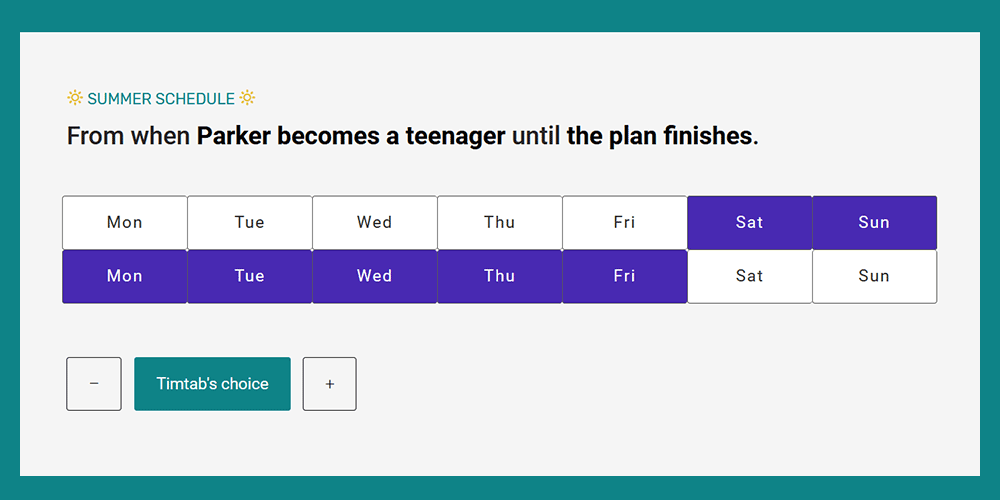
Week about (alternating weeks)
A common schedule is “week about” or “alternating weeks”. This fortnightly schedule is overused but works well in the summer when children are older.
Summer 13+
60/40 Custody Schedule Examples
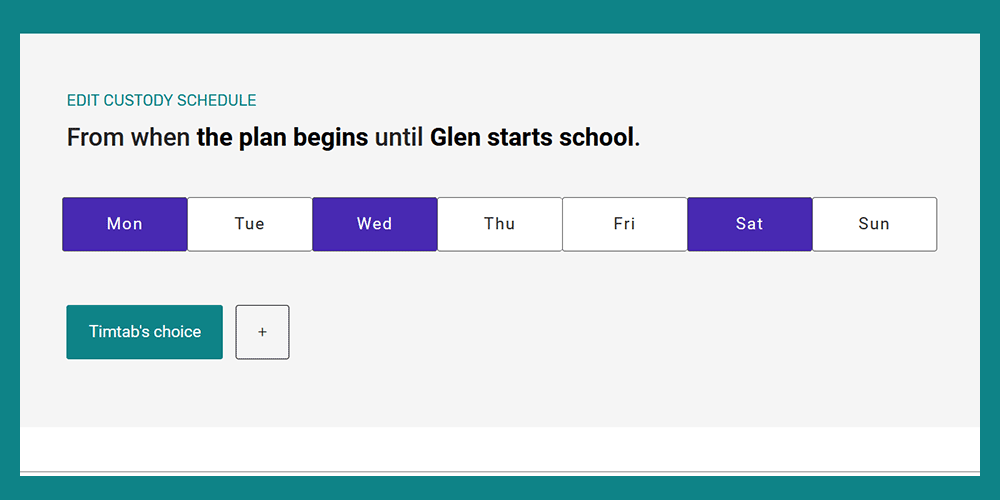
Mon-Wed-Sat (3 visits a week)
For an infant, toddler or other preschooler, short visits are best. The Mon-Wed-Sat schedule gives the secondary carer 3 short visits each week. These could be overnight stays depending on child age(s).
Ages 0-5
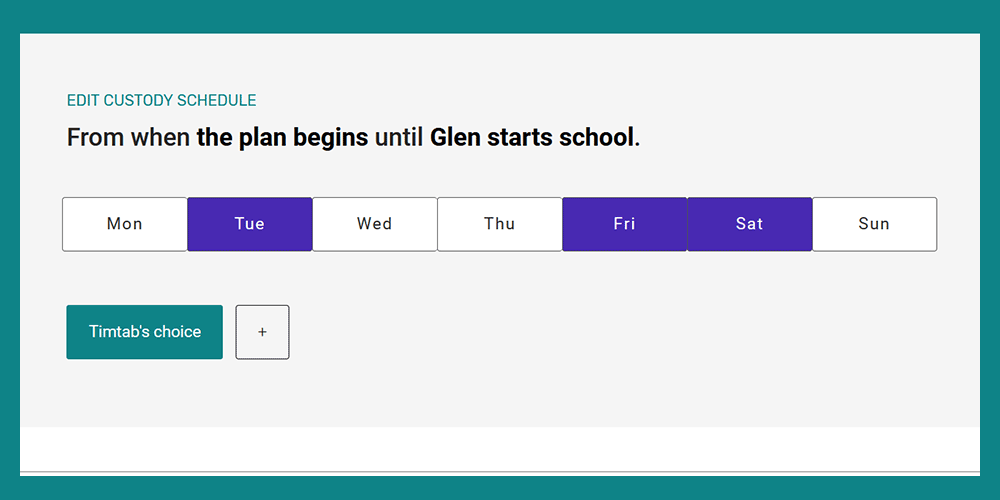
Tue-Fri-Sat (3 days a week)
For a preschooler whose parents live quite a distance apart, a 1-2 weekly schedule can work nicely. In the example, one parent has care every Tuesday and Fri-Sat.
DistanceAges 0-5
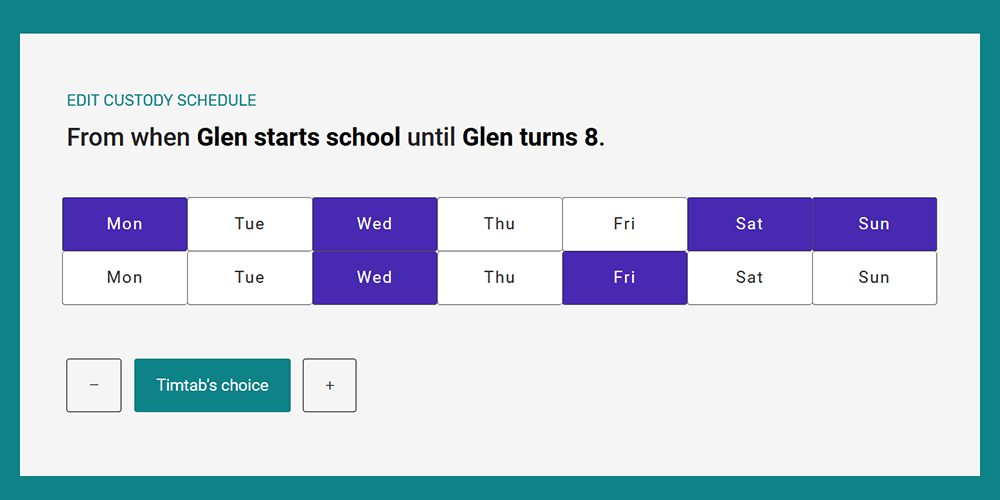
1-1-2-1-1 (5 visits a fortnight)
When a school child is not ready for long stays away from Mom or Dad, the 1-1-2-1-1 schedule is a good one. Extra travel is minimal if both parents can easily do school pick ups and drop offs.
Ages 5-8
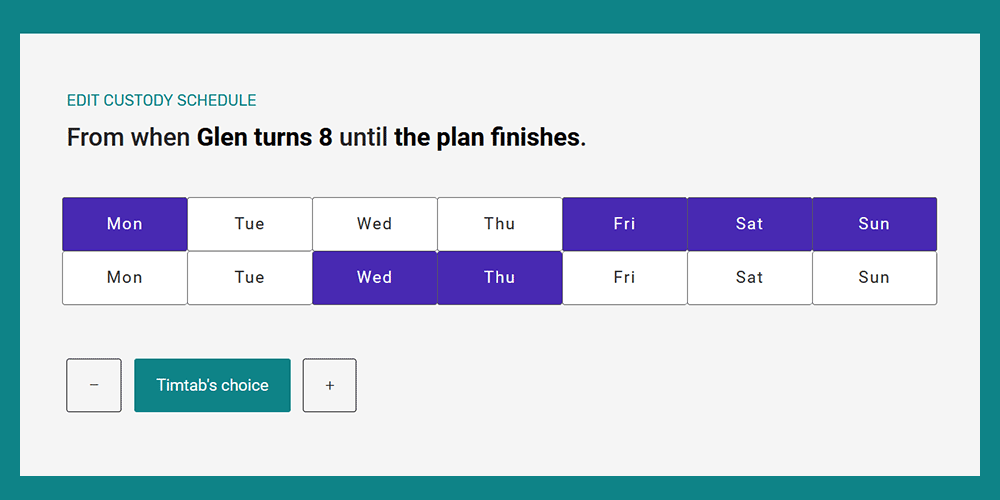
3-2-1 (classic 60/40)
3-2-1 is a well-balanced schedule and a close variation on the 3-2-2. The timetable has alternating blocks but with one parent having every Tuesday (or every Wednesay if preferred).
Ages 13+Ages 8+
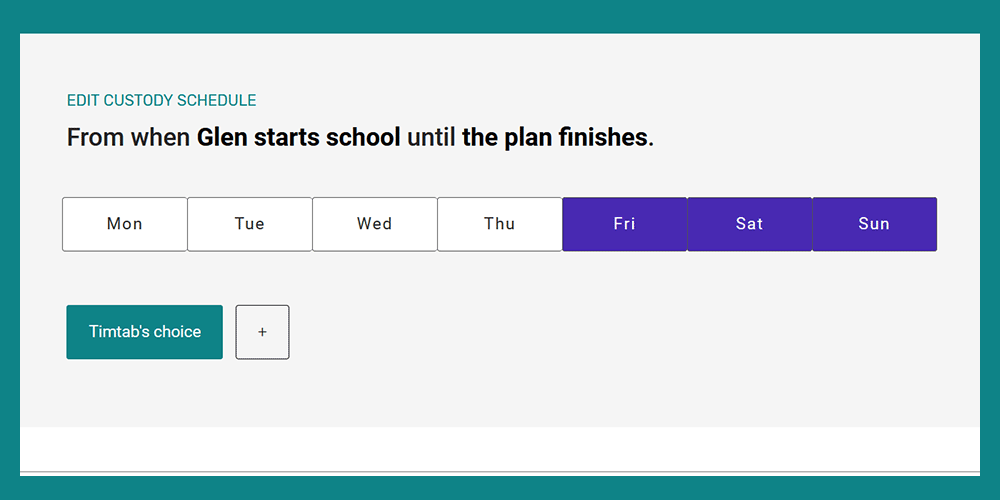
Every weekend (extended)
If a parent can’t do school runs, they could instead have the child every weekend for a 3-day visit. The drawback is that the child is always “away” on the weekend.
DistanceAges 13+Ages 8+Ages 5-8
65/35 Custody Schedule Examples
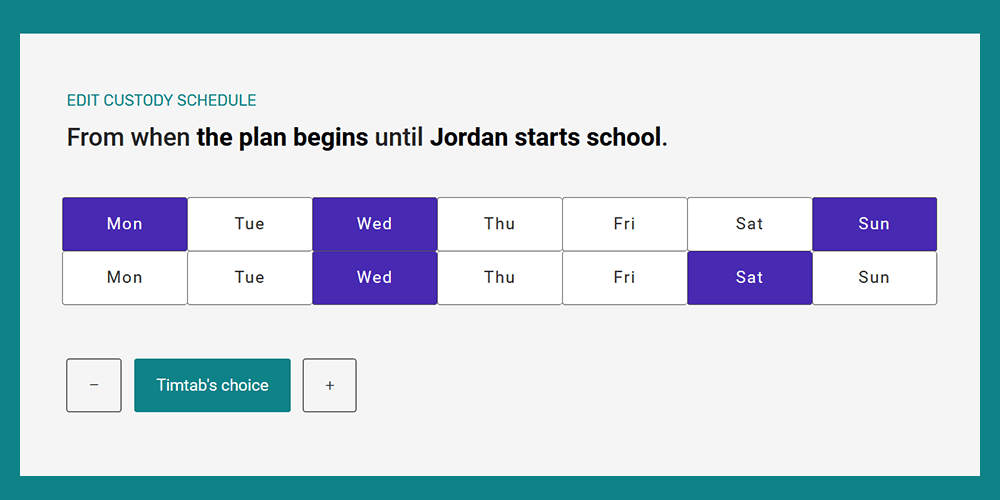
Wednesday and alternating Sat, Sun, Mon
A baby, toddler or other preschooler can see both parents often with a 65/35 split. For example, the secondary carer can have every Wednesday. As well, the days from Saturday to Monday alternate between parents.
Ages 0-5
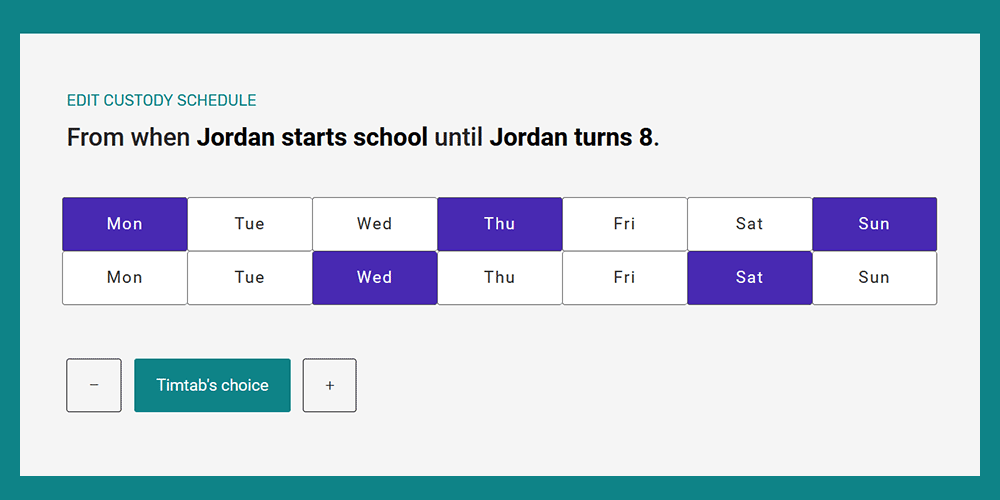
1-2 repeat (5 single days spread over fortnight)
For a young schoolchild, a good example schedule is a repeating cycle of 1 day with one parent and then 2 days with the primary carer. For convenience, most changeovers can happen via school.
Ages 5-8
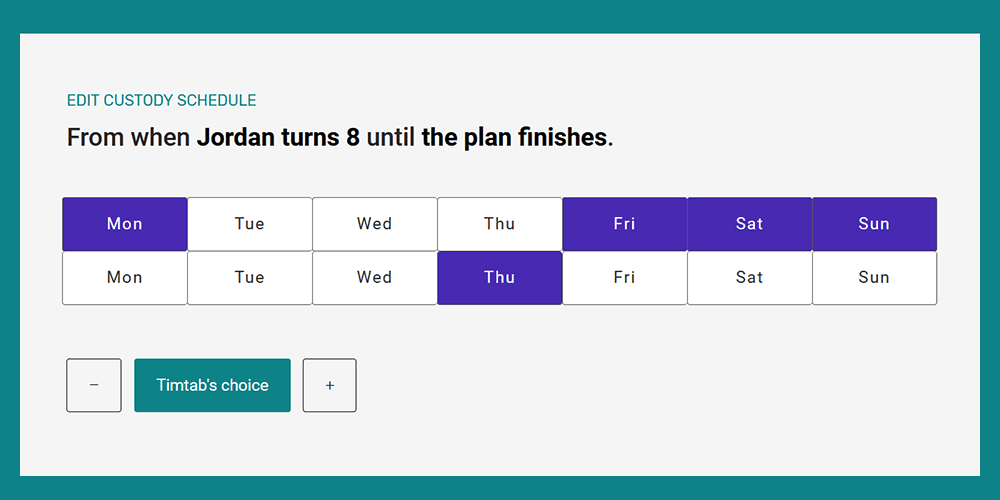
1-3-1 (classic 65/35)
The classic 65/35 schedule has a 3-day visit every other weekend. As well, the child visits the non-primary carer on alternating Mondays and Thursdays. Time away is a few days at most.
Ages 13+Ages 8+
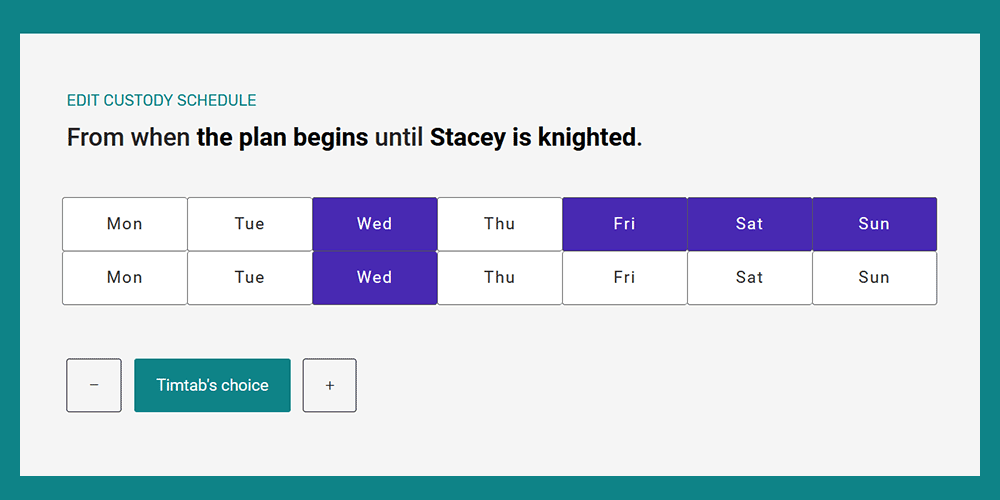
Every other weekend plus a mid-week visit
A common visitation schedule is for one parent to see their child every other weekend and on Wednesdays. While the timetable is simple to follow, the visits are poorly spaced out.
Better ones available
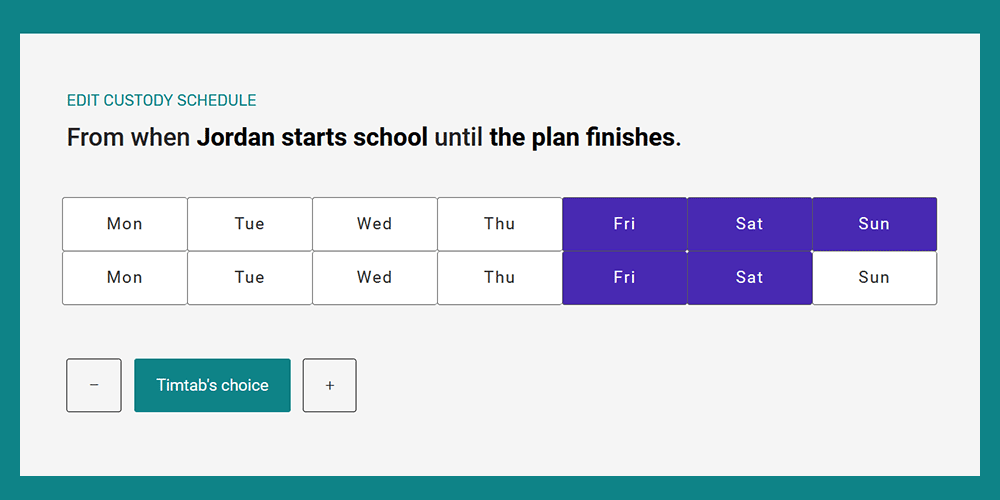
2 and 3 night weekends
If one parent lives far away (say, 90+ minutes), visits every weekend are needed for a 65/35 percentage split. Visits can alternate between 2 and 3 overnights.
DistanceAges 13+Ages 8+Ages 5-8
70/30 Custody Schedule Examples
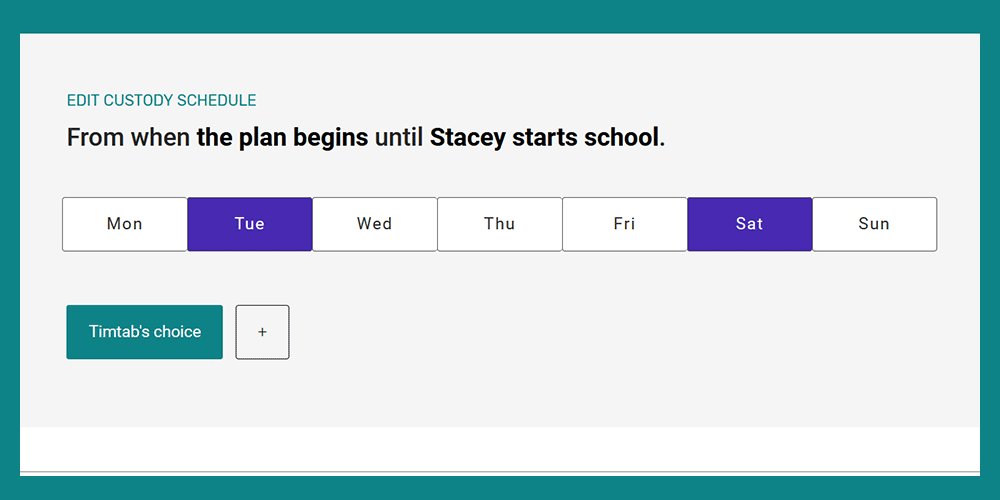
Tuesday and Saturday
30 percent custody works out to 2 days a week. Tuesday and Saturday visits is a good pairing, balancing a visit at the start of each weekend with a weekday visit.
Ages 0-5
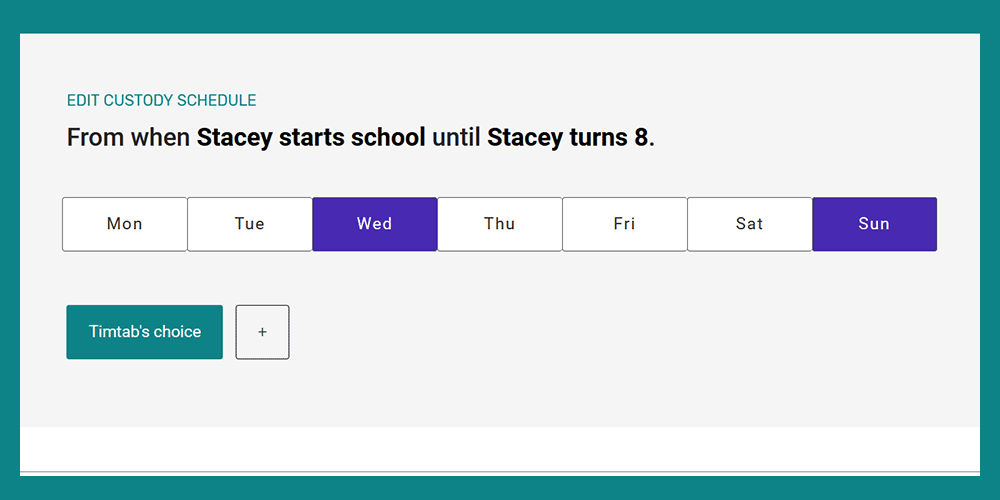
Wednesday and Sunday
Once a child is going to school, Wednesday and Sunday are good times to visit the secondary carer. A Sunday overnight allows the parent to drop the child off at school Monday morning.
Ages 5-8
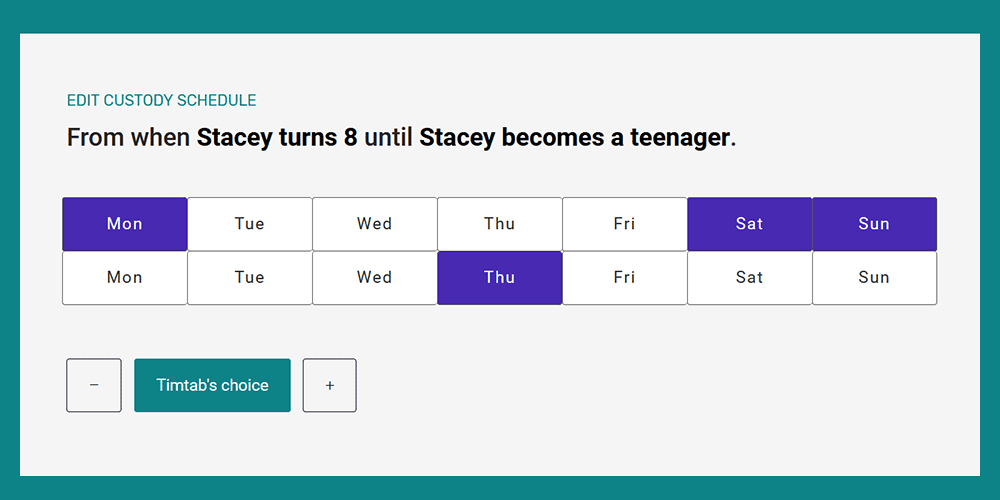
1-2-1 (classic 70/30)
With the classic 70-30 schedule, one parent has a 2-night visit every other weekend. They also have overnight visits on the Thursday and Monday either side of their weekend off.
Ages 8+
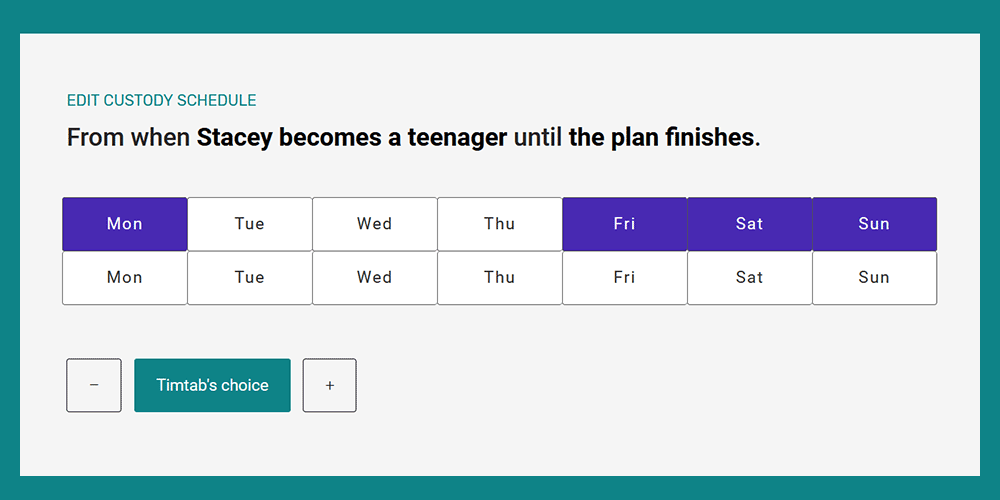
Extended weekend plus a Monday
For a teenager, a popular 70/30 custody plan is every other weekend (3 nights) plus a Monday. The Monday visit shortens time away from the non-primary carer.
Ages 13+
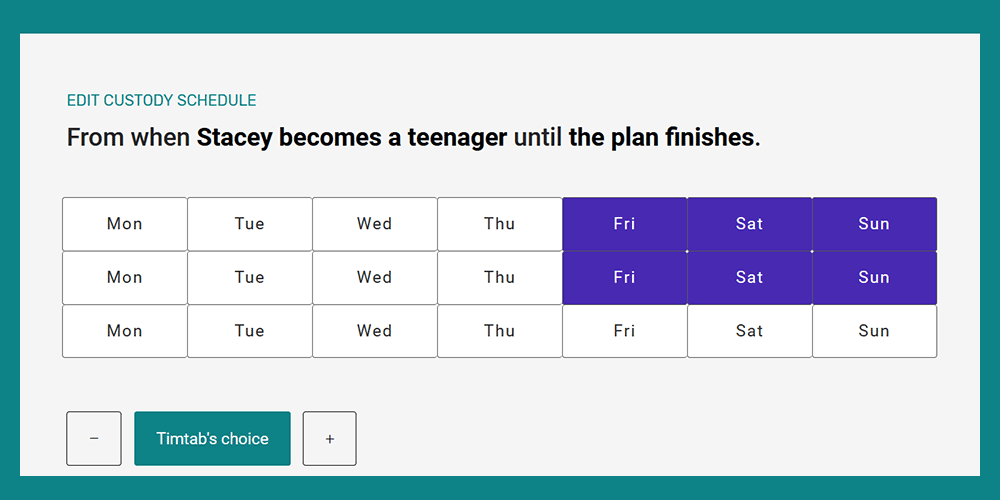
2 out of 3 weekends
A tri-weekly schedule is a good way for a teen to regularly see a parent who lives far away. 2 out of 3 weekends are spent with the long-distance parent.
DistanceAges 13+
80/20 Custody Schedule Examples
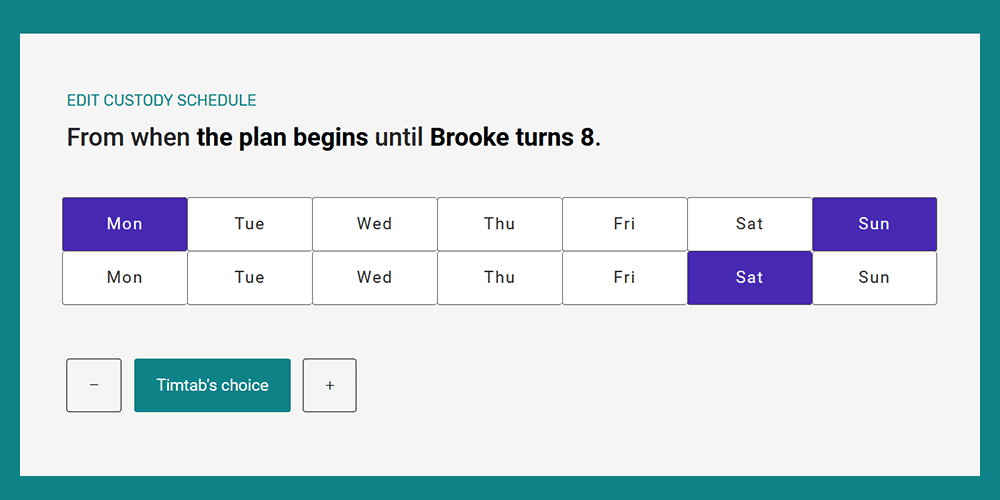
A Monday, Sunday and Saturday each fortnight
80/20 works out to only a few days each fortnight for one parent. The best example schedule for a young child has these visits on a Monday, Sunday and Saturday.
Ages 5-8Ages 0-5
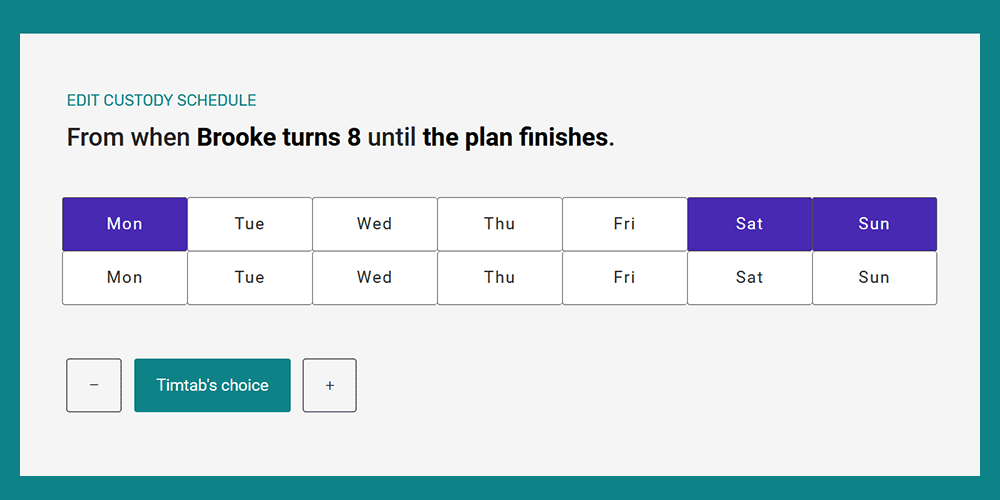
Every other weekend plus a Monday
For older children, the “20% parent” can provide care for 2 nights every other weekend as well as the Monday following their week off. The Monday visit prevents a large gap between visits.
Ages 13+Ages 8+
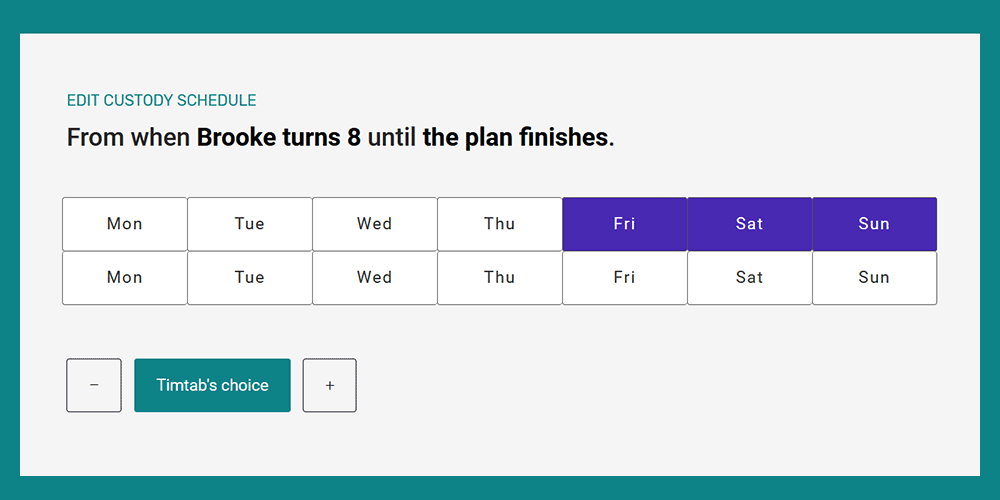
Every other weekend (extended)
If one parent lives far from school, the best 80/20 schedule for an older child is every other weekend. The child visits the parent for 3 consecutive nights each fortnight.
DistanceAges 13+Ages 8+
85/15 Custody Schedule Examples
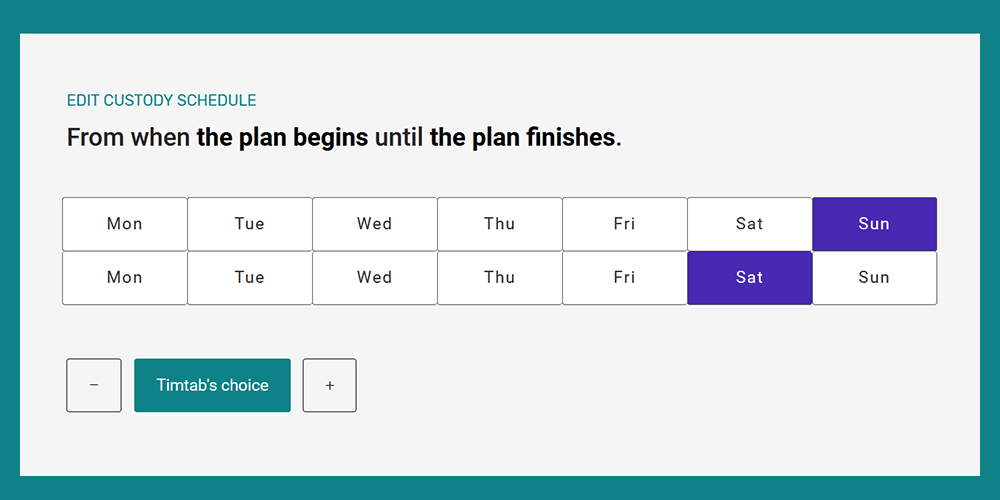
A Sunday and Saturday each fortnight
An 85/15 split means one care day a week for one parent. A schedule that works OK at all ages is to have the weekly visit alternate between Saturday and Sunday.
Ages 13+Ages 8+Ages 5-8Ages 0-5
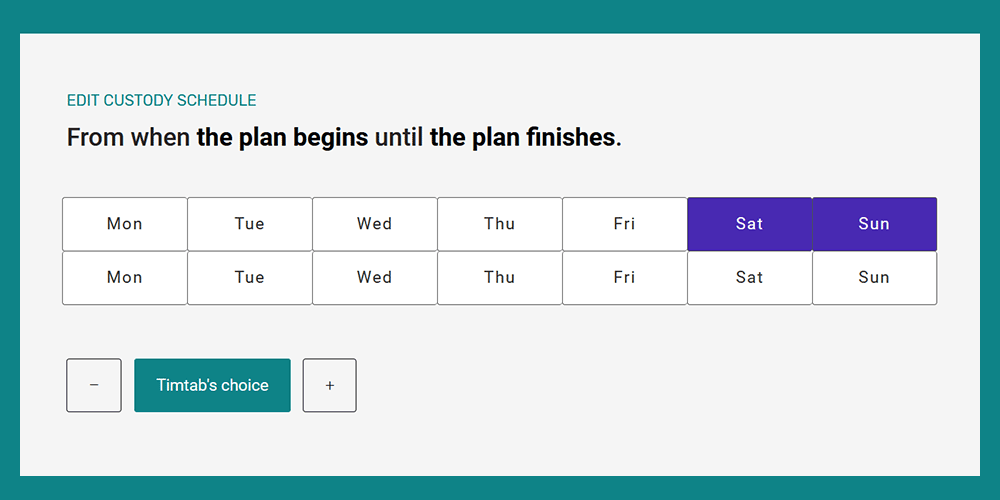
Every other weekend
Every other weekend is the main 85/15 schedule when one parent lives some distance away. For younger children, only use this if travel times are very long.
DistanceAges 13+Ages 8+Ages 5-8Ages 0-5

Find a schedule that works for you
Getting the right schedule is super important. Kids need to see their parents regularly – but with limited travel. The fact is that schedules handed down by judges are usually sub-optimal.
Dr Andrew Lancaster
TIMTAB FOUNDER
Custody Schedule Articles
Toddlers … best parenting plans for kids aged under 450/50 benefits… why shared parenting is important50/50 not working… when co-parenting has negative effects on children60/40 schedules… alternating weekends plus more70/30 schedules… 2 out of 7 nights visitation80/20 schedules… 3 out of 14 nights examples
